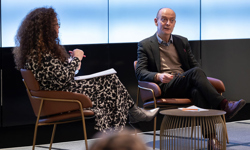The Independent Publisher Conference this year split into two streams: ‘Strategic: Product, People, Profit’ and ‘Multi-Channel: Community, Content, Technology’. I plonked myself down in the Strategic Stream and didn’t move! So, if you’re looking for insight and analysis of the many no-doubt excellent sessions in the Multi-Channel Stream …. sorry about that!
Economic cycle – are you ready for the upturn?
According to Phil Ives, partner at management consultancy Shirlaws, we’re currently in a period of “hesitant and uneven” recovery, but in macro-economic terms, we’re about to embark on a prolonged period of sustained growth. Great news, of course, but it’s not simply a question of waiting for the good times to roll; companies need to be investing now, as we come out of recession. Now is the time to sow the seeds of future growth. Innovation is what’s needed.
When speaking to senior management, Phil comes across three barriers to innovation. “It’s too costly”, say some, to which he counters, “can you afford not to?”
“We haven’t got the time,” say others. Phil advises these busy-bees to take a step back and look objectively at their business, dividing their company’s activities into three colour-coded areas: Red (back-office / admin), Blue (revenue generating) and Black (long term, strategic). The most successful companies, says Phil, are those that allocate sufficient time to the Black.
And, thirdly, “it’s too difficult!” The thought of ‘innovating’ is too overwhelming for some. Phil advises them to see innovation as simply a process of ‘doing something different’. As Ian Gerrard of Caspian Media said, innovation does not have to be about large ideas – it’s ok to think in terms of “innovation increments”. But there was general agreement that not innovating was not an option; basically, you just have to get on with it!
How to be an innovative company
It’s almost impossible to be an innovative company without an inspirational leadership that fully buys into the need to innovate. There’s an old Italian proverb, said Haymarket’s Adrian Barrick, that if you want to see if a fish is rotten, look at its head. But it’s not just a question of dynamic chief execs; a flat and fluid leadership structure is vital too, said Adrian, because the old school command and control hierarchy is totally unsuited to today’s publishing environment.
Innovation needs champions at the most senior levels of an organisation, but it also needs, said Ian Gerrard, to be in the DNA of the business, from top to bottom. Simply giving someone a job title with the words ‘business development’ in it, is not sufficient; the whole company needs to be geared up for it and it needs to be systemised with a clear appraisal process. Companies shouldn’t be waiting, agreed Phil Ives, for an “innovation moment”, or that flash of inspiration. The process of innovation needs to be locked into a system, that facilitates, nurtures and celebrates it.
Being open about the key financial drivers of the organisation and instilling an understanding of ‘profit’ at all levels of the business was found to be a good way of filtering out some of the more unrealistic ‘innovations’ early on, not that anyone was suggesting that innovations had to necessarily be profitable in the short term.
The people problem
Having forward looking leadership and the right structures in place are vital, but if you haven’t got the right people, then you’re on a hiding to nothing.
Paul Farrer of recruitment company Aspire said that according to survey after survey, the one thing that kept CEOs awake at night was ‘talent’. C21 Media’s David Jenkinson said that retaining good staff was one of his company’s main challenges. For him, this meant trying to make the company the kind of place people would want to work at, quickly rooting out people who didn’t fit in and offering flexible working arrangements. Being located somewhere cool like Shoreditch helps too!
Paul recommended that publishers should focus as much on retention as they did on recruitment – to treat all employees as if they were trying to hire them.
For Alison Hunter, HR director at Dennis, training staff to give them the skills and flexibility to cope with the rapidly changing challenges they all face, helped foster a positive working environment as did listening to their concerns. Through peer group discussions and round tables, the company sought to listen to staff, bring their anxieties into the open and to then develop action plans to deal with them. “Get them to talk; listen to them, don’t tell them,” advised Alison.
Creating a work place which fosters learning and where individuals felt that their skills and careers were being developed was very positive, particularly in situations where you were demanding more from staff, without necessarily paying them more. At Adrian’s previous company, UBM, they had developed an intranet where best practice and key learnings were documented and shared by staff – a living, growing repository of knowledge for all the staff to contribute to and benefit from.
Anyone know a good salesman?
It’s not just a question of holding onto your best people. For many smaller publishers, finding good people in the first place, especially sales people, is an ongoing challenge.
In the Q&As following one panel discussion, Wanderlust’s Lyn Hughes, asked from the floor, “does anyone know a good sales person?” A refreshingly honest and down to earth question which highlights that, for many smaller publishers, day-to-day bread and butter issues frequently trump the long term strategic ones.
While no one was about to hand over the name of their prize sales person to Lyn, Mark Allen, chairman of Mark Allen Group, did offer up some interesting advice. Don’t always look to recruit through the obvious and conventional channels. When it comes to sales people, look for a “can do attitude”, but be open minded about where you might find it.
One of his best sales people ever, he found at Heathrow T5. She was working as a waitress at Giraffe, and managed to persuade Mark to try the Mexican breakfast special. Mark was so impressed, that he offered her a job. Mark has also in the past, successfully employed someone just out of prison. He’d been locked up for a drugs offence, but looking for a job after his release, he had impressed Mark with his positive attitude.
Platform choices
Of course, multi-platform publishing continues to pose an opportunity and a challenge for all publishers. Two themes that came up more than once in the sessions was an emerging disappointment with tablets and a reaffirmation of the enduring power of print.
One of the instant polls launched by moderator Mark Frith between sessions, asked: “Where are you mainly focusing your innovation?” to which the assembled attendees responded via their keypads: Print: 38%; Web: 30%; Tablet: 2%; Smartphone: 5%; About the same for each: 25%. 2%!!!
Square Up Media’s Tim Slee said that the “iPad is proving a bit of a wash-out for the industry at the moment” and C21’s David Jenkinson also admitted that the “iPad had not been great so far”, although he was hopeful that an increased focus on producing audio-visual material would help turn that situation around next year. The iPad was seen as something of a saviour when it first appeared in 2010, but since then, performance has not matched expectation. The million dollar question is whether that state of affairs is down to the platform or how publishers are using it.
In contrast, there was a big thumbs up for print from a number of speakers. Mark Allen was confident that print would still be around in a hundred years’ time. He felt that many publishers had crossed the Rubicon and prematurely closed print titles, or stopped investing in them.
Print is alive and well. Earlier in the week, Tim Slee’s Square Up Media had launched a print spin-off to its digital offering, Foodism. The print version of Foodism has a 110 thousand print run and is aimed at foodies in the capital. It’s one of a growing trend of digital brands launching print products.
Wanderlust’s Lyn Hughes said, “print magazines are so powerful.” They still work extremely well for advertisers, she said, but worried that “getting that message across was really hard.”
No one was suggesting rolling back the years to the pre-digital era. There is a future in both and the challenge is to nurture both.
Video
Another snap poll: “In terms of diversifying revenue sources over the past 12 months, which of the following has been most important to your business?” The response: Introducing new digital products: 51%; Digitising archived content: 6%; Hosting events: 31%; Monetising data: 12%; Developing a video strategy: 0%. Yes, zero.
But moderator Mark Frith wasn’t going to let a complete lack of interest get in the way and the half day conference ended with a discussion on … video.
To be fair, the closing panel of Lisa Barnard (Illustrated London News) Lyn Hughes (Wanderlust) and Diane Young (Carnynx Group) were interested in video but there were big challenges.
For Lisa, cost was the biggest issue, with the consequent challenge for demonstrating ROI and making a margin. ILN do a lot of agency work and their clients are showing increased interest in video. They had recently, for one of their own titles, Sphere, launched a series of magazine style video programmes, focusing on particular subjects (‘chocolate’ was the first) and these were proving successful.
Lyn referred to the amazing success of Vloggers like Zoella and the fact that young people were much more likely to be watching YouTube than TV, but as far as Wanderlust was concerned, cost was still too big a hurdle.
Diane Young saw video as a huge opportunity but also complained about the cost, particularly of editing, which “typically took five times as long as you think it should”. Her title, The Drum, had recently dipped its toe in the water and set up a YouTube channel, and were getting lots of views. She sees it as an exciting growth area and now has a head of TV and anticipates being in the market for a specialist account manager soon.
And, not forgetting that C21 Media’s David Jenkinson had earlier in the day said that producing more audio-visual was one of his company’s objectives for the coming 12 months, seeing that as one way of getting more traction on tablets.
Carpe diem
A final thought then from the first speaker of the day, Phil Ives. A team at Harvard had apparently done some research into the moment of ‘clinical death’. They had found a group of people who had, at one stage or another, been declared clinically dead, but who had subsequently been revived. They were asked about the experience of death. What was it like? And the one word they had all used to describe the moment was ‘regret’! Regret for decisions not made and opportunities not taken. In ten years’ time, wondered Phil, how many businesses will be regretting not innovating now?












